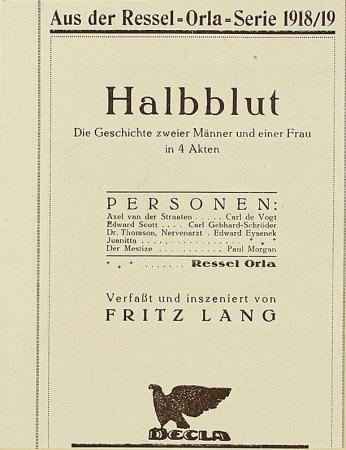It is estimated that between eighty and ninety percent of all silent films, as well as a significant number of sound films, are irretrievably lost. There are several reasons why this is so – although often, in individual cases, we can only speculate as to exactly why a particular film is lost. The following text outlines some of the more common explanations given by film experts over the years.

Nothing Sacred:
Film has never been a sacred medium. Tales of famous films being altered by studio hands against the director's wishes are well documented but this is only the tip of the iceberg. Alterations continued to be made (and in some cases still continue to be made) throughout a film's existence.
Censorship:
Once completed, a film would usually have to be approved by a local censorship body before it could be screened in a particular area. Frequently cuts were demanded before the film was deemed suitable for release. Censorship laws could differ from country to country, even city to city, and in areas where the censorship laws were more severe, more severe cuts usually had to be made.
In The Cinema:
Making it past the censors relatively unscathed was only half the battle. Once released to cinemas, the safety of a film print could not be guaranteed. If a film proved particularly popular at the box office, it would often be deliberately shortened by exhibitors so that they could squeeze more screenings into their programmes each day.
Breaking Down:
When subjected to frequent use, parts of a film print (or even entire prints) were apt to become broken or damaged. If that was the case, then the affected section could be excised and the print re-joined by the projectionist on duty to ensure a smoother performance at the expense of narrative wholeness. Sometimes, if projectionists saw a sequence from the film they particularly liked but which wasn't damaged, they would cut it out of the print anyway just to keep for themselves.
A Worthless Commodity:
In all these cases, rather than retain the excised material so that it might one day be reinstated back into the film, it was often merely thrown away. For film was always thought of as an ephemeral medium. Once it had outlived its commercial value, and was no longer thought capable of generating a profit, a film was very often deemed expendable. If prints or negatives could not be sold, they were sometimes given away to those who had the means or the desire to keep them. More often than not, they were abandoned – or simply destroyed.
Sweeping Change:
The early part of the 1930s saw the widespread conversion to sound and most of the films, which had been produced before this (the so-called 'silent' films) were not spared in the conversion. The vast majority of films produced during the silent era no longer exist today, with an estimated eighty to ninety percent of all the films produced worldwide during this period believed lost forever.

'From the ashes...' The Film Archives:
Coinciding with the change over to sound in the cinemas, the first film archives began to emerge specifically to protect the rapidly disappearing silent film heritage. As the oldest surviving examples of the medium, silent films are still a major concern of film archives today, when many sound films are also highly endangered. In 1938 the first organisation of film archives, the Fédération Internationale des Archives du Film (FIAF), was established. Many more film archives have appeared since and today FIAF claims over 120 members worldwide (and there are still many more film archives, which are not FIAF members).
Safe at Last...?
Unfortunately, a film was not always safe once it had entered the supposed sanctity of the archive. All archives are subject to space restrictions and many have often found that they cannot physically contain the vast quantity films coming into them. At times, it has been necessary for some archives to reduce their collections, with the unfortunate loss of several valuable and important films in the process. Of the films that were kept, meanwhile, many have permanently suffered at the hands of over zealous archivists in the past, who believed they were 'improving' the film by correcting supposed 'flaws'. With the benefit of hindsight, archivists today are fortunately far more careful when working with the artefacts in their collections – but mistakes can still happen.
Recycling Films:
Until about 1951, most motion picture film stock was manufactured on cellulose nitrate, a flexible base containing a degree of silver in the light-sensitive emulsion. In the past, old prints were often melted down so that the silver content could be recovered and reused. Such actions now seem absurd but at the time, in an industry motivated primarily by money, people didn't think twice about recovering the expensive silver instead of paying to keep the now useless film on the shelves.
Danger! Old Films:
Films produced on cellulose nitrate base are today considered especially vulnerable and in greatest need of immediate preservation. 'Nitrate won't wait' was the frequent call of the film archives in the past. However, nitrate films are also highly dangerous and today archives are still debating whether or not to keep original nitrate material once it has been preserved onto 'Safety' stock. When stored under ideal temperature and humidity conditions, a nitrate print can last for one hundred years or more but under less ideal conditions the film base starts to break down, giving off poisonous, acidic gases in the process. At higher surrounding temperatures, the film can spontaneously combust and the flames will not subside until the entire film had been dessicated. An inestimable amount of films, and a tragic number of human lives, are believed to have been lost to fires, whether in studio vaults, archives or elsewhere, over the years.
This Film Will Self-Destruct in...?
Even the best efforts of the archives at conserving the film heritage cannot alter the fact that film is an inherently self-destructive medium. Once manufactured, it immediately starts to decompose, albeit slowly at first, but if not stored under the right conditions the decomposition process is accelerated. It is a sad fact but eventually all films will be lost.
Preservation: A Slow and Painful Death?
To ensure its ongoing existence, archives and highly specialised laboratories carefully preserve each endangered film's photographic contents onto fresh film stock. Unfortunately, each time a film is copied in this way, some information is lost. As time goes by, the original elements will cease to exist. The copies themselves will eventually start to decompose and will have to be copied again if the film is intended to survive any further. In theory, the process could continue ad infinitum. With each reproduction bringing with it a loss of information, however, the film's eventual and inevitable disappearance can only be delayed – not avoided.